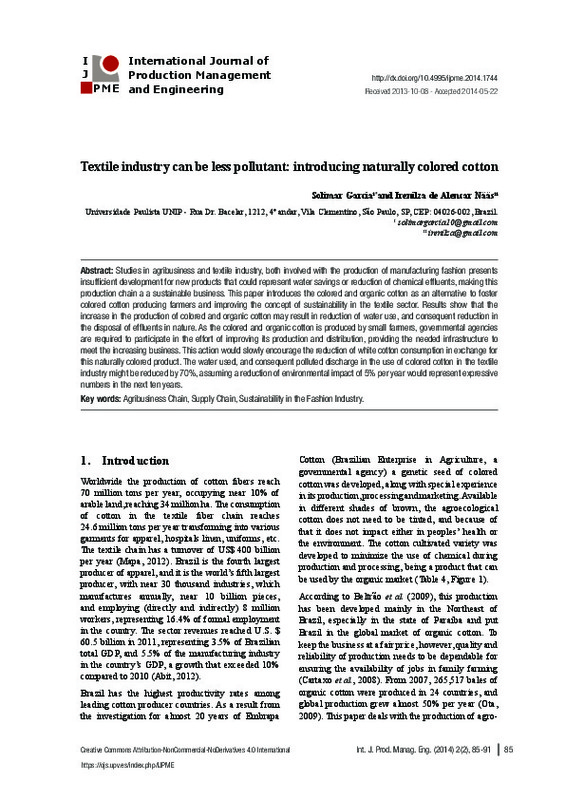JavaScript is disabled for your browser. Some features of this site may not work without it.
Buscar en RiuNet
Listar
Mi cuenta
Estadísticas
Ayuda RiuNet
Admin. UPV
Textile industry can be less pollutant: introducing naturally colored cotton
Mostrar el registro sencillo del ítem
Ficheros en el ítem
| dc.contributor.author | Garcia, Solimar
|
es_ES |
| dc.contributor.author | de Alencar Nääs, Irenilza
|
es_ES |
| dc.date.accessioned | 2015-05-18T10:25:42Z | |
| dc.date.available | 2015-05-18T10:25:42Z | |
| dc.date.issued | 2014-07-11 | |
| dc.identifier.issn | 2340-5317 | |
| dc.identifier.uri | http://hdl.handle.net/10251/50385 | |
| dc.description.abstract | [EN] Studies in agribusiness and textile industry, both involved with the production of manufacturing fashion present insufficient development for new products that could represent water savings and reduction of chemical effluents, making this production chain a sustainable business. This paper introduces the colored and organic cotton as an alternative to foster colored cotton producing farmers and improving the concept of sustainability in the textile sector. Results show that the increase in the production of colored and organic cotton, may result in reduction of water use, and consequent reduction in the disposal of effluents in nature. As the colored and organic cotton is produced by small farmers, governmental agencies need to participate in the effort of improving its production and distribution, providing the needed infrastructure to meet the increasing market. This would slowly encourage the reduction of white cotton consumption in exchange for this naturally colored product. The water used, and consequent polluted discharge in the use of colored cotton in the textile industry might be reduced by 70%, assuming a reduction of environmental impact of 5% per year would represent expressive numbers in the next ten years. | es_ES |
| dc.description.sponsorship | The authors wish to thank Capes, for the support of this study. | |
| dc.language | Inglés | es_ES |
| dc.publisher | Editorial Universitat Politècnica de València | |
| dc.relation.ispartof | International Journal of Production Management and Engineering | |
| dc.rights | Reconocimiento - No comercial - Sin obra derivada (by-nc-nd) | es_ES |
| dc.subject | Agribusiness Chain | es_ES |
| dc.subject | Production management | es_ES |
| dc.subject | Supply Chain | es_ES |
| dc.subject | Sustainability in the Fashion Industry | es_ES |
| dc.title | Textile industry can be less pollutant: introducing naturally colored cotton | es_ES |
| dc.type | Artículo | es_ES |
| dc.date.updated | 2015-05-18T10:13:00Z | |
| dc.identifier.doi | 10.4995/ijpme.2014.1744 | |
| dc.rights.accessRights | Abierto | es_ES |
| dc.description.bibliographicCitation | Garcia, S.; De Alencar Nääs, I. (2014). Textile industry can be less pollutant: introducing naturally colored cotton. International Journal of Production Management and Engineering. 2(2):85-91. https://doi.org/10.4995/ijpme.2014.1744 | es_ES |
| dc.description.accrualMethod | SWORD | es_ES |
| dc.relation.publisherversion | https://doi.org/10.4995/ijpme.2014.1744 | es_ES |
| dc.description.upvformatpinicio | 85 | es_ES |
| dc.description.upvformatpfin | 91 | es_ES |
| dc.type.version | info:eu-repo/semantics/publishedVersion | es_ES |
| dc.description.volume | 2 | |
| dc.description.issue | 2 | |
| dc.identifier.eissn | 2340-4876 | |
| dc.contributor.funder | Coordenaçao de Aperfeiçoamento de Pessoal de Nível Superior, Brasil | |
| dc.description.references | Abreu, M. C. S. de, Castro, F. de, Soares, F. de A., & Silva Filho, J. C. L. da. (2012). A comparative understanding of corporate social responsibility of textile firms in Brazil and China. Journal of Cleaner Production, 20(1), 119-126. doi:10.1016/j.jclepro.2011.08.010 | es_ES |
| dc.description.references | Baskaran, V., Nachiappan, S., & Rahman, S. (2012). Indian textile suppliers’ sustainability evaluation using the grey approach. International Journal of Production Economics, 135(2), 647-658. doi:10.1016/j.ijpe.2011.06.012 | es_ES |
| dc.description.references | Carvalho, L. P. de, & Santos, J. W. dos. (2003). Respostas correlacionadas do algodoeiro com a seleção para a coloração da fibra. Pesquisa Agropecuária Brasileira, 38(1), 79-83. doi:10.1590/s0100-204x2003000100011 | es_ES |
| dc.description.references | Damiano VB (2003). As indústrias de materiais lignocelulósicos em busca de tecnologias amigas da natureza. Revista UNORP. v. 3, n. 2, p. 49-61. | es_ES |
| dc.description.references | Demir, A., Özdoğan, E., Özdil, N., & Gürel, A. (2010). Ecological materials and methods in the textile industry: Atmospheric-plasma treatments of naturally colored cotton. Journal of Applied Polymer Science, 119(3), 1410-1416. doi:10.1002/app.32575 | es_ES |
| dc.description.references | Forgiarini E. (2006). Degradação de Corantes e Efluentes Têxteis PelaEnzima Horseradish Peroxidase (HRP). Dissertação de Mestrado do Programa de Pós–Graduação em Engenharia Química do Centro Tecnológico, da Universidade Federal de Santa Catarina. Florianópolis – Santa Catarina. | es_ES |
| dc.description.references | Galindo, C., Jacques, P., & Kalt, A. (2001). Photooxidation of the phenylazonaphthol AO20 on TIO2: kinetic and mechanistic investigations. Chemosphere, 45(6-7), 997-1005. doi:10.1016/s0045-6535(01)00118-7 | es_ES |
| dc.description.references | Vautier, M., Guillard, C., & Herrmann, J.-M. (2001). Photocatalytic Degradation of Dyes in Water: Case Study of Indigo and of Indigo Carmine. Journal of Catalysis, 201(1), 46-59. doi:10.1006/jcat.2001.3232 | es_ES |
| dc.description.references | Mendes FD. (2010). Um estudo comparativo entre as manufaturas do vestuário de moda do Brasil e da Índia. Tese de doutorado. Universidade Paulista. São Paulo: 2010. | es_ES |
| dc.description.references | Norum, P. S., & Ha-Brookshire, J. E. (2011). Consumer Trade-Off Analysis and Market Share Estimation for Selected Socially Responsible Product Attributes for Cotton Apparel. Clothing and Textiles Research Journal, 29(4), 348-362. doi:10.1177/0887302x11425956 | es_ES |
| dc.description.references | Pan, Z., Sun, D., Sun, J., Zhou, Z., Jia, Y., Pang, B., … Du, X. (2010). Effects of fiber wax and cellulose content on colored cotton fiber quality. Euphytica, 173(2), 141-149. doi:10.1007/s10681-010-0124-0 | es_ES |
| dc.description.references | Ramalho FS, Azeredo TL., Fernandes FS., Nascimento Júnior JL, Malaquias JB, Nascimento ARB, Silva CAD, Zanuncio JC. (2010). Food intake and utilization of Alabama argillacea (Hübner) (Lepidoptera: Noctuidae) fed on cotton cultivars with colored fibers. Journal of Pest Science. | es_ES |








